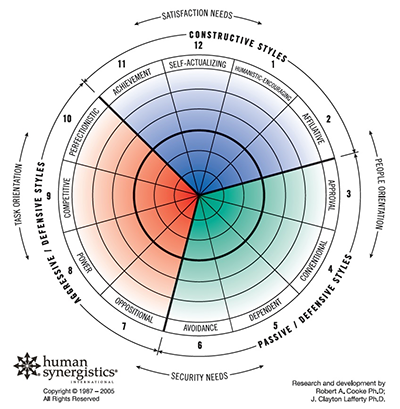 Ken is highly experienced in using Human Synergistics products, with life-time accreditation status awarded in 2016. He is accredited in Life Style Inventory (LSI), Group Style Inventory (GSI) and Organisational Culture Inventory (OCI) and Organisational Effectiveness Inventory (OEI) tools in 2008, and followed up accreditation in Management/Impact (MI) in 2013, and Leadership/Impact (LI) in 2014. He has used the LSI with over 400 clients, the OCI/OEI with four organisations, and has used the LI and MI with a number of leaders across Perth and Australia.
Ken is highly experienced in using Human Synergistics products, with life-time accreditation status awarded in 2016. He is accredited in Life Style Inventory (LSI), Group Style Inventory (GSI) and Organisational Culture Inventory (OCI) and Organisational Effectiveness Inventory (OEI) tools in 2008, and followed up accreditation in Management/Impact (MI) in 2013, and Leadership/Impact (LI) in 2014. He has used the LSI with over 400 clients, the OCI/OEI with four organisations, and has used the LI and MI with a number of leaders across Perth and Australia.
Human Synergistics is an organisation that has a conglomeration of significant diagnostic tools that assist in enabling behavioural improvement and change at the individual, group and organizational level. For more information on Human Synergistics and their diagnostic tools, the following description of the tools borrows in part from the HS publication: “Why Culture and Leadership Matter”, published in 2014.
Human Synergistics has a common language with the Circumplex (pictured), which allows individual managers and leaders understand how they are perpetuating the current state through their thinking and behaviour. The insight that is achieved through the use of the Human Synergistic tools empowers and motivates individuals to make changes that directly increase performance.
Life Style Inventory
The Life Style Inventory (LSI) is a 360 degree tool, with the LSI1 (self-description) designed to measure how the individual perceives themselves on the basis of everything they believed they have learned about themselves over their life. It is especially effective at measuring personal thinking styles, how one thinks about themselves (self-concept) having a direct impact on one’s personal self-efficacy. Self-efficacy being defined as the more effective we think we are at what we do, the more likely we will undertake tasks and interact with others successfully. The LSI1 can be measured against the LSI2 (description by others), which measures how others perceive us. Our personal behavioural style (how we approach tasks and interact with others) impacts how others see us in terms of our effectiveness in undertaking our current role, how we interact with others and how we respond to people and situations. The LSI2 measures this by focusing on observed behaviour, these being the styles one uses when approaching tasks and interacting with others. This tool is very popular with managers and leaders, in terms of getting a baseline of how they are see themselves and how they are seen by others. Opportunities for improvement are identified when the LSI1 is matched against the LSI2, and this is worked through in via a thorough debrief with follow up coaching sessions on identified actions.
Leadership/Impact
The Leadership/Impact (LI) tool is a measurement and feedback tool designed to help those in leadership positions identify the relationship between how they lead, how this impacts on the behaviour of others and how effectively they operate in a leadership role. Similar to LSI, it has two parts – a self-description and feedback from others. THe LI is specifically designed for senior executives and high level leaders, and can improve leadership and organizational culture. The Leadership/Impact measures 10 critical functions a leader performs and the impact of their actions on others. This process identified the methods the leader use to move the organization, highlighted in two ways, namely prescriptive leadership strategies which guide or direct the activities and behaviours of others towards goals, opportunities and methods, or restrictive strategies which constrain or prohibit activities and behaviours with respect to goals, opportunities and methods. Effective leaders are constantly aware of the impact they have on others, this tool is brilliant in helping them understand that impact.
Management/Impact
The Management/Impact (MI) tool is specifically designed for middle managers. It helps managers identify the relationship between how they manage, how they impact on the behaviour of others, thereby providing insight into how effective they are as managers. Again, like the LSI and LI, it has two parts: a self-description and feedback from others. The Management/Impact recognises the impact managers have on culture, in that they model the behaviours that others follow, causing others to behave in certain ways that may or may not be consistent with what the organisation actually desires. Once understood, the manager can then develop new ways of managing, resulting in more effective and constructive behaviour.
Organisational Culture Inventory/Organisational Effectiveness Inventory
The Organisational Culture Inventory (OCI) and Organisational effectiveness Inventory (OEI) work in combination to measure the ideal and prevailing organisational culture and practices that impact on the culture. These organisational-level survey tools are used by organisations and provide a comprehensive analysis of what’s happening within an organisation and how this results in existing levels of individual, group, team and organisational performance. The OCI maps the results against the Circumplex. The OEI has identified causal factors, which are levers for change. These are broken into five categories namely Mission and Philosophy, Structures, Systems, Technology and Skills/Qualities. The OEI categorises culture into individual-level, group-level and organisational-level outcomes.

